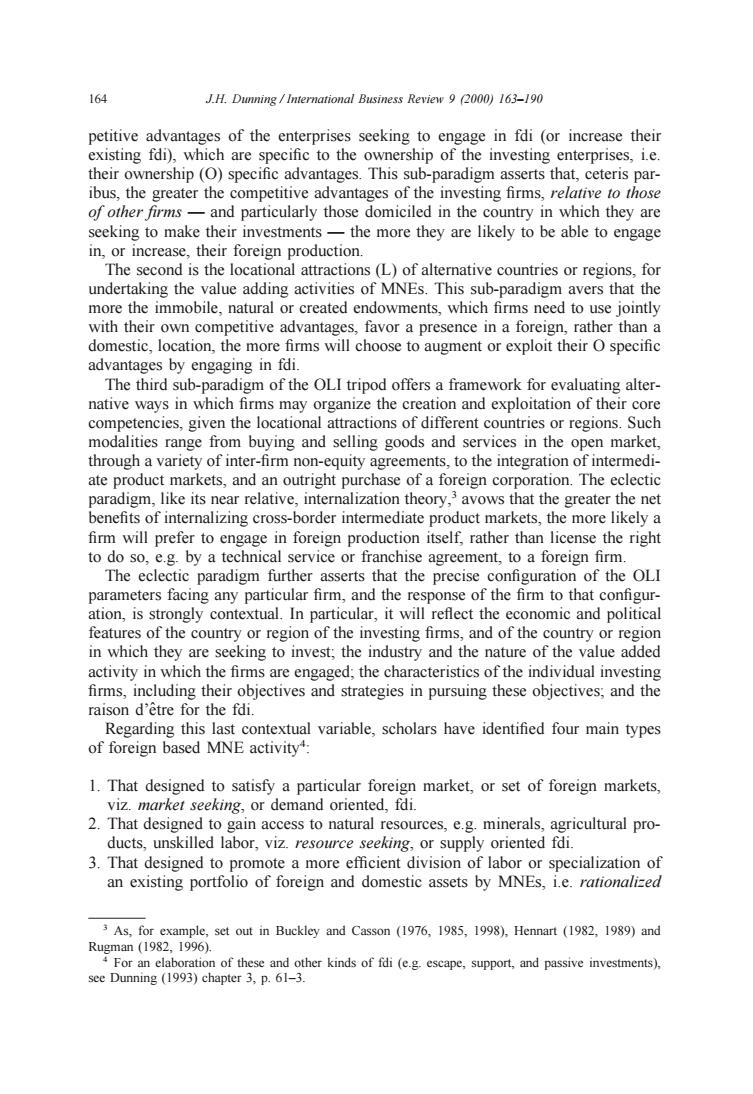正在加载图片...

164 J.H.Dunning/International Business Review 9 2000)163-190 petitive advantages of the enterprises seeking to engage in fdi (or increase their existing fdi),which are specific to the ownership of the investing enterprises,i.e. their ownership(O)specific advantages.This sub-paradigm asserts that,ceteris par- ibus,the greater the competitive advantages of the investing firms,relative to those of other firms-and particularly those domiciled in the country in which they are seeking to make their i investme the more they are likely to be able to engage n creas their fo duction The the loc onal (of alter e countries or regi fo ing the di of MNEs.Th more the immobile,nat 0 with thei created owments,which firn own competitive advantag er than a nestic, n,the more advantages by The third sub-paradigm of the OLI tripod offers a framework for evaluati ing alter native ways in which firms may organize the creation and exploitation of their core competencies,given the locational attractions of different countries or regions.Such modalities range from buying and selling goods and services in the open market, through a variety of inter-firm non-equity agreements,to the integration of intermedi- ate product markets,and an outright purchase of a foreign corporation.The eclectic paradigm,like its near relative,internalization theory,avows that the greater the net benefits of internalizing cross-border intermediate product markets,the more likely a firm will prefer to enga age in foreign production itself,rather than license the right to do so,e.g.by a techn ical se rvic or franchise agreement,to a foreign firm. The eclectic paradigm 6 ther asserts that the of the OLI articular firn and the res nse of the firm to that config tion tual In articular,it will 月ct the nomic and eat of th of the ng f and of t n w the oinvest: he the orhe activity in which rms are engaged;th aracteristics of vidual inve nrms,including th bjectives and strategies in pursuing these objectives;and the raison d'etre f the fdi Regarding thi Ia: t contextual variable,scholars have identified four main types of foreign based MNE activity. 1.That designed to satisfy a particular foreign market,or set of foreign markets, viz.market seeking,or demand oriented,fdi 2.That designed to gain access to natural resources,e.g.minerals,agricultural pro- ducts,unskilled labor,viz.resource seeking,or supply oriented fdi. 3.That designed to promote a more efficient division of labor or specialization of an existing portfolio of foreign and domestic assets by MNEs,i.e.rationalized 3 As for eman set out in Buckley and Casson (1976.1985.1998).Hennart (1982.1989)a164 J.H. Dunning / International Business Review 9 (2000) 163–190 petitive advantages of the enterprises seeking to engage in fdi (or increase their existing fdi), which are specific to the ownership of the investing enterprises, i.e. their ownership (O) specific advantages. This sub-paradigm asserts that, ceteris paribus, the greater the competitive advantages of the investing firms, relative to those of other firms — and particularly those domiciled in the country in which they are seeking to make their investments — the more they are likely to be able to engage in, or increase, their foreign production. The second is the locational attractions (L) of alternative countries or regions, for undertaking the value adding activities of MNEs. This sub-paradigm avers that the more the immobile, natural or created endowments, which firms need to use jointly with their own competitive advantages, favor a presence in a foreign, rather than a domestic, location, the more firms will choose to augment or exploit their O specific advantages by engaging in fdi. The third sub-paradigm of the OLI tripod offers a framework for evaluating alternative ways in which firms may organize the creation and exploitation of their core competencies, given the locational attractions of different countries or regions. Such modalities range from buying and selling goods and services in the open market, through a variety of inter-firm non-equity agreements, to the integration of intermediate product markets, and an outright purchase of a foreign corporation. The eclectic paradigm, like its near relative, internalization theory,3 avows that the greater the net benefits of internalizing cross-border intermediate product markets, the more likely a firm will prefer to engage in foreign production itself, rather than license the right to do so, e.g. by a technical service or franchise agreement, to a foreign firm. The eclectic paradigm further asserts that the precise configuration of the OLI parameters facing any particular firm, and the response of the firm to that configuration, is strongly contextual. In particular, it will reflect the economic and political features of the country or region of the investing firms, and of the country or region in which they are seeking to invest; the industry and the nature of the value added activity in which the firms are engaged; the characteristics of the individual investing firms, including their objectives and strategies in pursuing these objectives; and the raison d’eˆtre for the fdi. Regarding this last contextual variable, scholars have identified four main types of foreign based MNE activity4 : 1. That designed to satisfy a particular foreign market, or set of foreign markets, viz. market seeking, or demand oriented, fdi. 2. That designed to gain access to natural resources, e.g. minerals, agricultural products, unskilled labor, viz. resource seeking, or supply oriented fdi. 3. That designed to promote a more efficient division of labor or specialization of an existing portfolio of foreign and domestic assets by MNEs, i.e. rationalized 3 As, for example, set out in Buckley and Casson (1976, 1985, 1998), Hennart (1982, 1989) and Rugman (1982, 1996). 4 For an elaboration of these and other kinds of fdi (e.g. escape, support, and passive investments), see Dunning (1993) chapter 3, p. 61–3